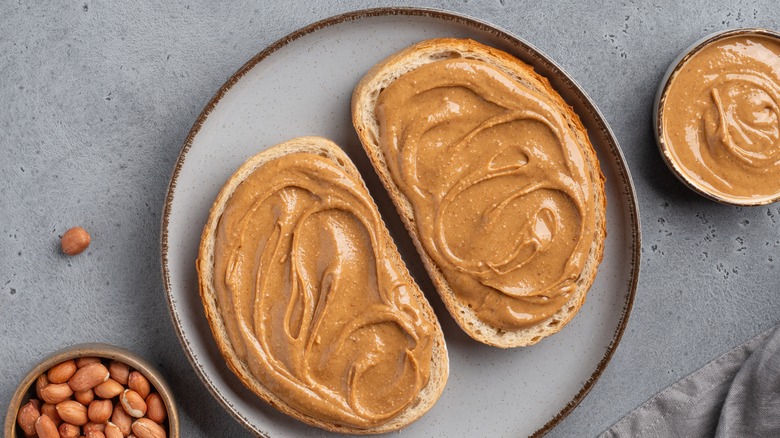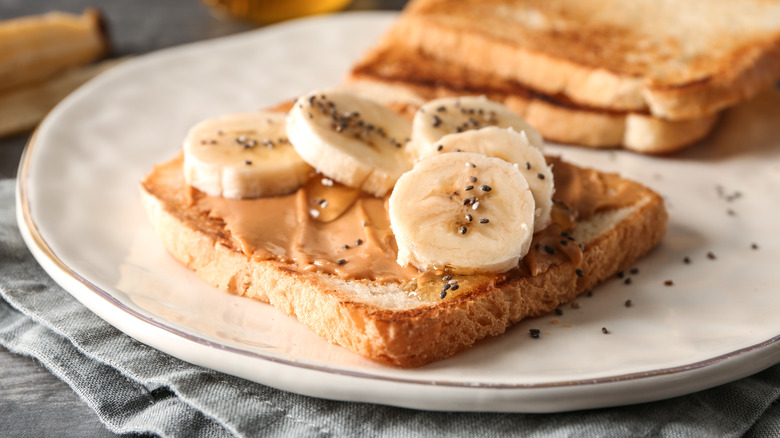How Much Protein A Peanut Butter Sandwich Really Has
Peanut butter sandwiches are popular for a number of reasons. Compared to more labor-intensive breakfast preparations like eggs on toast or pancakes, peanut butter sandwiches are far easier to prep. All you need are a jar of your favorite crunchy, smooth, or organic peanut butter and a few slices of bread. Plus, it's relatively inexpensive too.
The health benefits peanut butter offers are another major plus. In addition to being a good source of fiber and healthy fats (monounsaturated and polyunsaturated), the nutty breakfast spread is low-carb, with the added benefit of various vitamins and minerals, like vitamins E, B3, B5, and B6; folate; magnesium; copper; manganese; iron; potassium; zinc; and selenium.
If you work out or you're generally interested in upping your protein intake, a peanut butter sandwich first thing in the morning or at some point during the day can really help you out. The nut butter is famous for its protein content. But have you ever wondered just how much protein is in a peanut butter sandwich? According to the U.S. Department of Agriculture, you're looking at 6.43 grams of protein if you're spreading 32 grams of smooth-style peanut butter — that is two tablespoons — onto one slice of commercially-produced white bread. If you're having a whole sandwich, the number goes up to 12.9 grams. Let's break it down further.
The protein profile of a peanut butter sandwich
There are 20 essential amino acids that make up proteins, 11 of which your body produces naturally and the others must be obtained from food sources. Proteins are divided into incomplete and complete proteins. Incomplete proteins don't contain enough of all of the nine essential amino acids your body gets from food sources. Plant-based foods like nuts, legumes, seeds, whole grains, and vegetables generally fall under the category of incomplete proteins. However, foods like chia seeds, tofu, and quinoa are the exceptions. Animal-based proteins are also usually considered complete proteins.
Science has, however, come a long way from thinking that not consuming complete proteins and opting for incomplete proteins is somehow problematic. "For people who don't eat much meat, or no meat at all, a wide variety of plant foods such as legumes, lentils, nuts, seeds and whole grains on a daily basis will allow for you to get the complete proteins you need," explained registered dietitian Gillian Culbertson (via Cleveland Clinic). In fact, peanut butter can even compare to animal protein, nutrition-wise. Interestingly, when you combine peanut butter with whole grain bread, you're making a complete protein food source.
One slice of commercially prepared white bread (29 grams) has 2.57 grams of protein, per the U.S. Department of Agriculture. In comparison, one slice of whole wheat bread (32 grams) contains 3.97 grams of protein.
How to up your protein intake with a peanut butter sandwich
Protein is often referred to as the building block of your cells. As one of the three macronutrients, protein can help you feel full for longer, aid with improving muscle mass and strength, protect against age-related muscle deterioration, help with recovery after injury, and even boost your metabolism. Even the well-being of your skin, hair, and nails depends on adequate protein intake.
So, for those of you eating peanut butter every day, there are ways to turn an already protein-rich peanut butter sandwich into a super source of protein goodness. Aside from using whole grain bread instead of white bread, some examples include throwing in some slices of banana and chia seeds and adding other ingredients like raisins, dates, or walnuts to the sandwich. Even switching up your bread for something else like one extra-large whole wheat tortilla could work.
No matter how big of a fan you are of this breakfast food though, there is something called overdoing it. Keep an eye out for signs you're eating way too much peanut butter. It is considered a calorie-dense food so overconsuming it could lead to weight gain. Plus, people with nut allergies should be careful. Considered one of the most common allergies, a peanut allergy can bring about hives, itchiness around the mouth and throat, diarrhea, vomiting, nausea, a runny nose, and shortness of breath.



